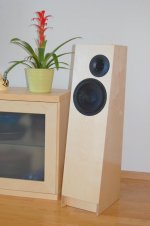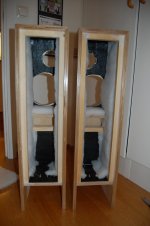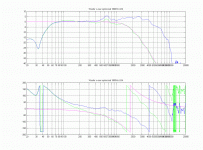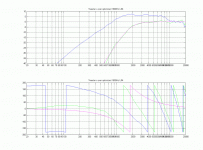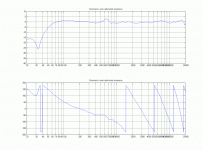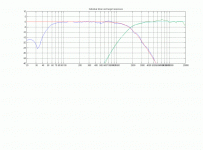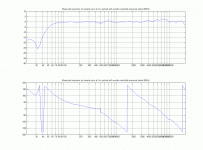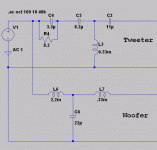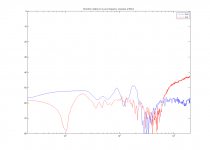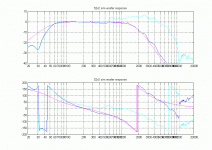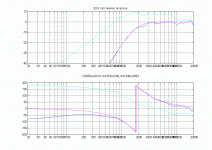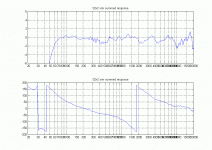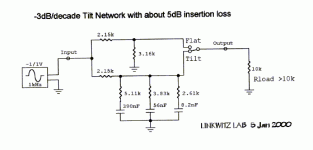Hi all!
This summer I made a pair of speakers, the second set of diy speakers I have made. It's a bass-refleks floor-standing 2-way. I already had the ScanSpeak 18W/8545K00 and then I wanted to try the SEAS DXT tweeter.
The cabinet is approx 17L and 85cm tall, and has the port tuned to 35Hz built into the front of the enclosure and exits at the floor. The front slants back about 5 degrees.
The bottom of the enclosure has room for an amplifier to be built in, as an active speaker with dsp xover is my ultimate goal. However I made a passive xover so that I could start using the speakers right away.
They sound great with excellent stereo imaging and deep powerful bass in my 25m^2 room.
I hope someone finds this useful and get some inspiration from it.
Thanks,
OJG
This summer I made a pair of speakers, the second set of diy speakers I have made. It's a bass-refleks floor-standing 2-way. I already had the ScanSpeak 18W/8545K00 and then I wanted to try the SEAS DXT tweeter.
The cabinet is approx 17L and 85cm tall, and has the port tuned to 35Hz built into the front of the enclosure and exits at the floor. The front slants back about 5 degrees.
The bottom of the enclosure has room for an amplifier to be built in, as an active speaker with dsp xover is my ultimate goal. However I made a passive xover so that I could start using the speakers right away.
They sound great with excellent stereo imaging and deep powerful bass in my 25m^2 room.
I hope someone finds this useful and get some inspiration from it.
Thanks,
OJG
Attachments
The speakers are made from 15mm birch plywood to match the furniture in the room: Improved WAF 
Then bitumen is added to all the walls, and one or more layers of acoustic wool. Here is a picture taken before all the damping is added and the back is mounted.
Then bitumen is added to all the walls, and one or more layers of acoustic wool. Here is a picture taken before all the damping is added and the back is mounted.
Attachments
My xover deign method is maybe a bit unusual. I use a combination of LTSpice and Matlab to design and optimize the xover. I did my measurements in my living room with Dennis Sbragions rec_imp. This limits the 0.5m measurement to above 500Hz.
I optimized the xover for acoustic LR4 at 1800Hz.
Here is the woofer response spliced with nearfield response below 500Hz. Blue is the driver response, pink is the target curve and green is the simulated response with the xover.
I optimized the xover for acoustic LR4 at 1800Hz.
Here is the woofer response spliced with nearfield response below 500Hz. Blue is the driver response, pink is the target curve and green is the simulated response with the xover.
Attachments
Excellent project
Very nice speakers!
We are on the same track. I am making speakers using a SS15W and the SS6600 tweeter. The tweeters are mounted to the back of the baffles and I am carving waveguides on the front. They will function very much like the DXT waveguide. Currently my prototypes are only rough MDF boxes.
Like your project, I am starting with passive crossovers (which has been a learning experience for me too). Later I will go to active crossovers as well, but I will probably use an analog op-amp configuration.
I look forward to your results with the digital crossovers.
Thanks for posting your pictures, it is encouraging me to continue working toward a nicely finished speaker.
Very nice speakers!

We are on the same track. I am making speakers using a SS15W and the SS6600 tweeter. The tweeters are mounted to the back of the baffles and I am carving waveguides on the front. They will function very much like the DXT waveguide. Currently my prototypes are only rough MDF boxes.
Like your project, I am starting with passive crossovers (which has been a learning experience for me too). Later I will go to active crossovers as well, but I will probably use an analog op-amp configuration.
I look forward to your results with the digital crossovers.
Thanks for posting your pictures, it is encouraging me to continue working toward a nicely finished speaker.
Here is a distortion measurement of the complete speaker with 2.83V input at 50cm on tweeter axis so it is only good above ~400Hz. Notice the very low distortion from 2500 to 6000Hz, a well-known property of waveguide tweeters by now, and one of my primary reasons for choosing the DXT.
Attachments
Hello again,
Well the speakers have been playing for a few months now. They work much better with more complex music than my previous speakers, i.e. the soundstage doesn't break down even though there are many instruments playing at the same time.
I do think they are a little on the bright side though. Not harsh, just bright. I am going to try and tweak the crossover to see if I can improve it further.
More posts to follow
OJG
Well the speakers have been playing for a few months now. They work much better with more complex music than my previous speakers, i.e. the soundstage doesn't break down even though there are many instruments playing at the same time.
I do think they are a little on the bright side though. Not harsh, just bright. I am going to try and tweak the crossover to see if I can improve it further.
More posts to follow
OJG
I did a measurement of the room response averaged across several locations in the room. Turns out that the peak at 650Hz is not a measurement artifact. It is probably a combination of a box resonance and port resonance, so I am going to put in a notch filter to dampen it.
Here is the new simulated woofer response. Much better phase response as well.
Here is the new simulated woofer response. Much better phase response as well.
Attachments
Hi OJG,
great project - congratulations
Few years ago I did a project with the same SS midbass and with revelator tweeter. It was a smaller bassreflex box, but that 650Hz peak was there . Actually I never saw a loudspeaker with that driver that didn't have it (including Sonus Faber Electa Amator II and Wilson Watt). So it's not a bug - it's a feature
great project - congratulations

Few years ago I did a project with the same SS midbass and with revelator tweeter. It was a smaller bassreflex box, but that 650Hz peak was there . Actually I never saw a loudspeaker with that driver that didn't have it (including Sonus Faber Electa Amator II and Wilson Watt). So it's not a bug - it's a feature

hi ojg:
this is the great project, your speakers box and curve looks fine, we should be learn!
But I'm worried about points will low frequency
1\ I worry tweeter whether we can afford too big power,
2\ reduction of sound realistic will change almost,although this curve looks good

jam
this is the great project, your speakers box and curve looks fine, we should be learn!
But I'm worried about points will low frequency
1\ I worry tweeter whether we can afford too big power,
2\ reduction of sound realistic will change almost,although this curve looks good

jam
ojg said:Next is the tweeter. I needed to reduce the broad peak at around 6kHz. I believe this is what made the speaker sound a little bright.
That is a common problem with most dome+cone speakeras. Flat on axis means 'bright' (too hot in HF) in power response. Perhaps aim to get the typical 'down slope' (I now seem to prefer to get a gentle 3dB downward curve). Again, it depends on type of music, as I do a lot of live classical (where large hall and huge distance from orchestra mean severely attenuated HF) maybe that skews my taste, don't know. A simple R-C filter between pre and power amp allows lots of experimantation. Along the lines that Liknwitz suggests
Attachments
- Status
- This old topic is closed. If you want to reopen this topic, contact a moderator using the "Report Post" button.
- Home
- Loudspeakers
- Multi-Way
- My Seas DXT + SS18W speaker
